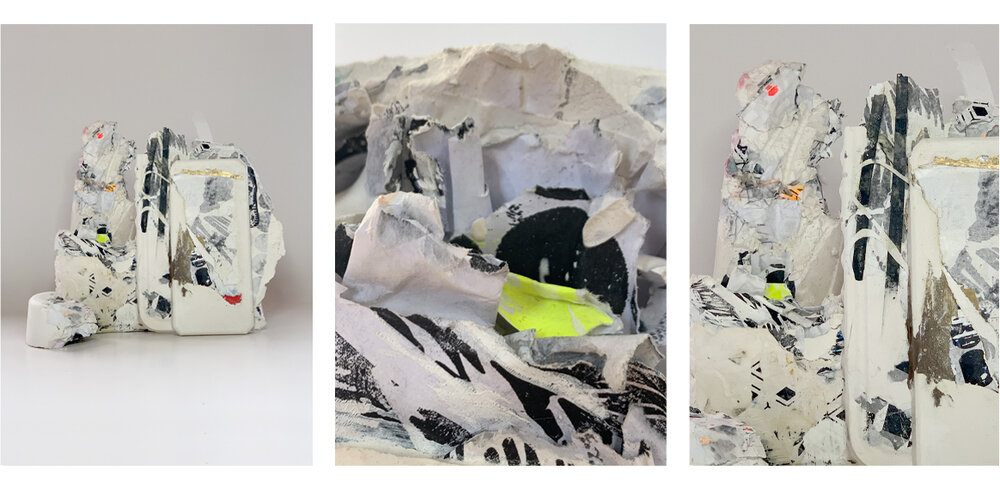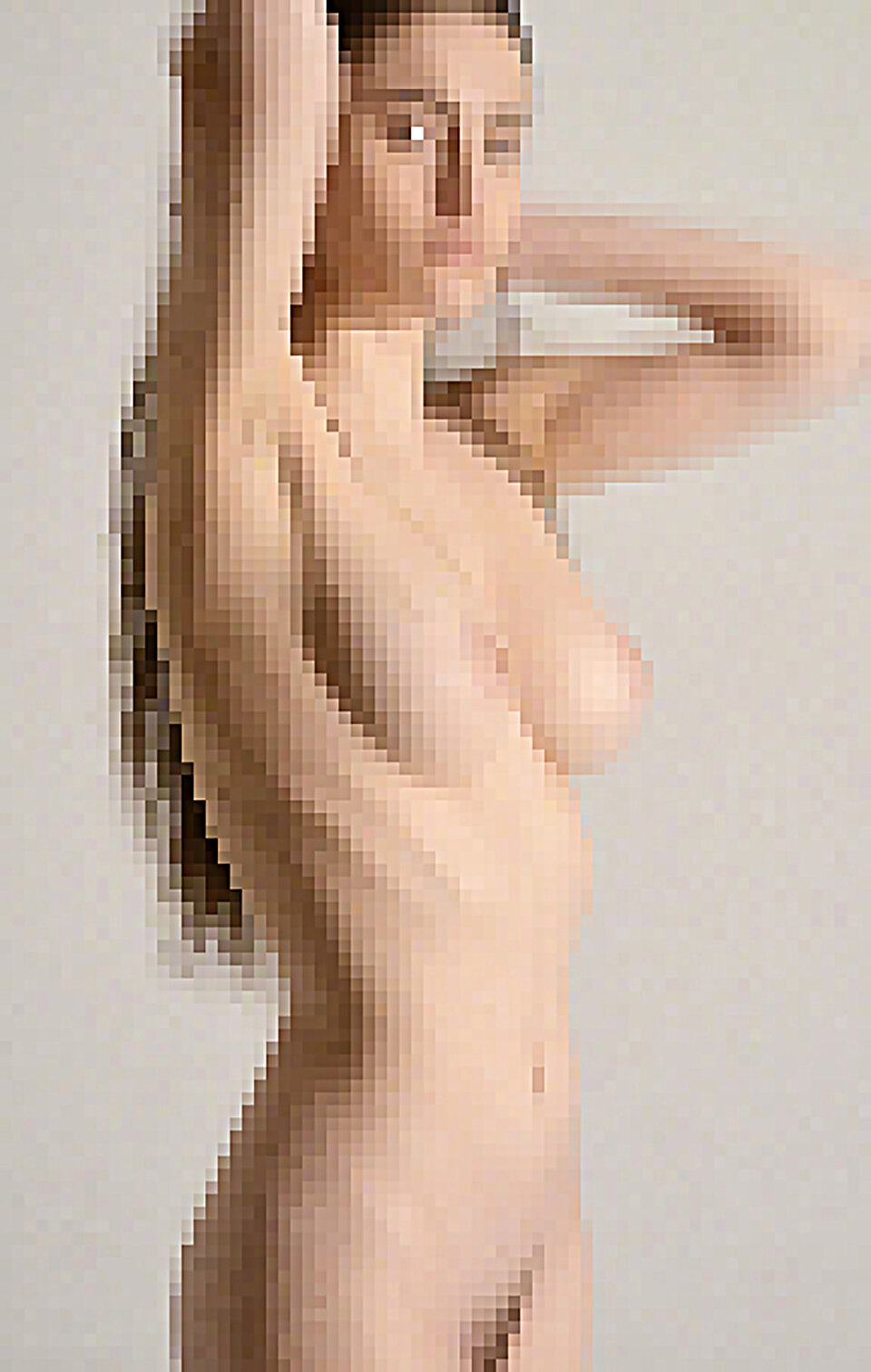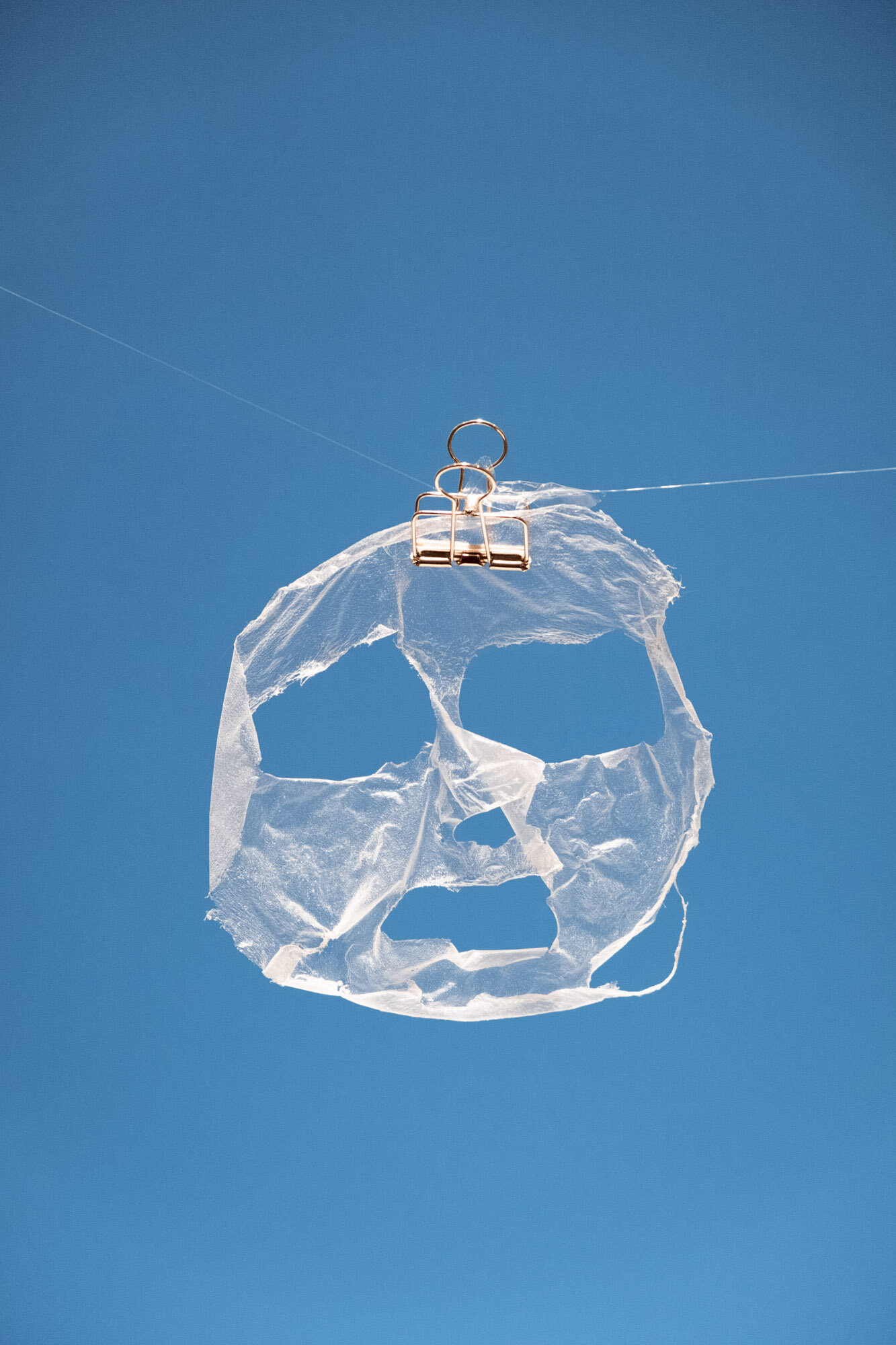(PT)
TEMPORAL reúne obras dos participantes do curso e grupo de estudos Arte e Transdisciplinaridade, dirigido por Gabriela Maciel e formado por artistas e profissionais de diversas áreas que estiveram durante um ano em diálogo online, de 2020 a 2021. Ao mesmo tempo em que cada um atravessa sozinho e coletivamente pelo “temporal” da pandemia, num período planetário complexo e desafiador, a criatividade artística e a crítica construtiva são trabalhadas também como forma de sobrevivência. Os diversos significados da palavra temporal ilustram de forma relevante esta época que estamos atravessando juntos. Esta mostra digital reúne trabalhos que surgiram da necessidade vital de expressão, através de práticas multi e transdisciplinares que envolvem a experimentação. Aqui abordamos questões plurais e diversas a respeito de confinamento, da sensação de isolamento; da complexa construção e destruição de camadas que preservam memórias; das relações entre corpo, tecnologia e materialidade; de situações estranhas, narrativas semi-ficcionais e conclusões sobre a realidade; da antítese da perfeição no meio digital; da combinação de aspectos orgânicos e digitais; da discussão virtual versus real; do mergulho em misticismos, paradigmas e descobertas que permeiam as múltiplas naturezas de interação; de perceber o tempo por meio da memória e vice-versa; da natureza de construção da imagem; de técnica mista como um projeto de web-arte; da poesia audiovisual de espaços internos; de abstrações digitais sobre a essência das plantas e sua conexão íntima com o homem e a natureza; de criações coletivas em tempos distópicos; da imperfeição e do amor, ou, na escuridão, uma fenda por onde a luz entra; de identidade, gênero e questões sociais; materializando imaterialidades; de novas formas de comunicação para transformar as questões ecológicas de nosso tempo; de tradições culturais de diferentes grupos étnicos, reconectando e valorizando nossa memória cultural e reiterando que todo organismo faz parte de um sistema interligado.
O temporal é passageiro
(EN)
TEMPORAL brings together works by the participants of the course and the study group Art and Transdisciplinarity, directed by Gabriela Maciel and formed by artists and professionals from different areas who attended online dialogues during one year, from 2020 to 2021. While each member has been, alone and collectively, through this “temporal” – pandemic storm –, during an extremely complex and challenging period of time we activate our artistic creativity and the enriching criticism also as a way of surviving. The different meanings of the word “temporal” illustrate this specific time we are crossing together. This digital exhibition presents works that were created with the vital necessity of artistic expression. Here we address plural and diverse issues regarding confinement, the feeling of isolation; the complexity of construction and destruction of layers that contain memories; the relationship between body, technology and materiality; the odd situations, semi-fictional narratives and conclusions about reality; the antithesis of perfection in the digital world, combining organic and digitalization aspects; the discussion of virtual versus real life; plunging into the mysticisms, paradigms, and discoveries that permeate the multiple aspects of interaction; perceiving time through memory and vice-versa; the nature of image-making; mixed media as a web-art project; the audiovisual poetry of inner spaces; the digital abstraction of images regarding the essence of plants and the intimate connection between man and nature; the collective creation during dystopian times; about imperfection and love, or a crack in darkness where the light gets in; the identity, gender and social issues; materializing the immaterial; the new ways of communication to transform the ecological matters of our time; the cultural traditions of various ethnic groups, reconnecting and valuing our cultural memory and reassuring that every organism is part of an interconnected system.
The storm is temporary’
Fernanda Schmidt
GABRIEL CASTRO
In Collaboration with AZULABULA
Regina Lemos
Sexto elemento / SIxth Element
Sylvia Lemos
Fernanda Schmidt, Brazilian, visual artist and graphic designer. Foxy Neighbor was born out of a feeling of isolation and lack of light. The lack of the sun, which I felt when I lived in Denmark and felt again in the first few months of confinement. Attempting to catch any sunlight that passed by my window I created a series of reflective, ray-catching objects bringing light into the house. Resting on window’s sills the pieces capture and redistribute light and heat. Some shapes surpass the boundaries of the window, projecting outwards or leaning on a neighbor’s sill sharing and receiving light.
Fernanda Schmidt, brasileira, artista visual e designer gráfica. Foxy Neighbor nasceu de um sentimento de isolamento e falta de luz, a falta do sol que eu sentia quando morava na Dinamarca e que voltei a sentir nos primeiros meses de confinamento. Tentava trazer a luz solar para dentro de casa, e desse desejo nasceu uma série de objetos brilhantes e reflexivos, capturadores de raios que se apoiam em peitoris das janelas, penduram-se do teto, e redistribuem luz e calor. Algumas formas extrapolam o limite da janela e vão buscar energia do lado de fora, projetadas, ou apoiadas no peitoril de um vizinho que compartilha e recebe luz.
Gabriel Castro (Rio de Janeiro, 1986) is a Textile Print Designer, Graphic Designer and Visual Artist currently living in Brooklyn, New York. With a deep interest in new media and formats, Gabriel’s work is the result of a complex construction and destruction of layers of paint and paper to create meaningful images in random visual patterns. His latest work, Gabriel explores the use of discarded materials, fragments of some of his previous paintings, to create wreckage sculptures that preserve memories of his creative process.
Gabriel Castro (Rio de Janeiro, 1986) é Designer de Estamparia, Design Gráfico e artista visual e atualmente vive no Brooklyn, em Nova York. Com profundo interesse em novas mídias e formatos, o trabalho de Gabriel é o resultado da complexa construção e destruição de camadas de tinta e papel, em que o artista cria imagens significativas, em padrões visuais aleatórios. Em seu mais recente trabalho, Gabriel explora o uso de materiais descartados, provenientes do processo de pinturas anteriores, para criar esculturas com fragmentos que preservam a memória do seu processo criativo.
Gabriel Junqueira (1992) is a Brazilian multimedia artist exploring the relationships between body, technology and materiality through digital images, sculptures, installations and music.
Gabriel Junqueira (Fortaleza, 1992) explora as relações entre corpo, tecnologia e materialidade em suportes como imagens digitais, esculturas e instalações.
Guilherme Gerais work's employs layered storytelling, fiction characters, built-up scenarios, weird situations, and is composed of a rich, tactile assortment of compositions, forms, textures, light, and creations of his own vivid imagination. His main interest lies in confounding semi fictional narratives and expected conclusions about reality. For the exhibition, "Temporal" Gerais presents the work "Sensual Fuzz" ( video, color, sound, 2020 ) in which it reflects on how reality can be perceived, constructed and manipulated in our mind through our senses, in this case exploring the concept of “virtual reality” and sound stimuli..
O trabalho de Guilherme Gerais é composto por um sortimento tátil de composições, formas, texturas e criações da sua própria imaginação, por meio da produção de fotografias, vídeos, peças sonoras, livros e instalações, com especial interesse na construção de narrativas semi ficcionais e divagações sobre a realidade. Para a exposição "Temporal" Gerais apresenta o trabalho "Sensual Fuzz" ( vídeo, cor, som, 2020 ) em que reflete sobre como a realidade pode ser percebida, construída e manipulada em nossa mente através de nossos sentidos, nesse caso explorando o conceito de “realidade virtual” e de estímulos sonoros.
Isabela de Vasques is a Brazilian visual artist and educator, graduated from the University of the Arts London, UK, where she lives and works, at present. Isabela’s multidisciplinary practice embraces experimentation and the desire to explore visual narratives.”Polaroid I and II” contemplate instances where the subjectivity of time is perceived in an imaginary between layers of paintings and drawings. “Parties always end up in the kitchen” is from a series of photo shoots in lockdown and portrays the artist’s fascination by synaesthesia, considering, without prejudice, a gift to perform beyond our common sensory perceptions.
Inviting coloured sounds
Helped pass the time
Slow Slowing Slowly
From light came movement -
Language portrayed
While I was abstractly playing Hermeto Pascoal’s ‘Jam’
‘heated’ the kitchen.
Isabela de Vasques, brasileira, é artista visual e educadora. Formada pela University of the Arts London, no Reino Unido, onde atualmente vive e trabalha. Sua prática multidisciplinar abraça a experimentação e a pesquisa sobre valores estéticos em busca de narrativas visuais. “Polaroid I & II” contemplam instâncias onde a subjetividade do tempo é percebida num imaginário, entre camadas de pinturas e desenhos. “O melhor da festa é sempre na cozinha” faz parte de uma série de ensaios fotográficos durante o lockdown e retrata a fascinação da artista pela sinestesia, considerando, sem preconceito, uma dádiva transcender as nossas percepções sensoriais comuns.
Jerônimo de Moraes, is a photographer and visual artist based in New York, that uses the intersections between static image and moving image as main elements of his work. Mega-pixel is a study of the antithesis of perfection in the digital photographic image. The exacerbated pixel showcases the numeric intervention/interpretation that is so commonly suppressed in this media. The research combines organic and digitized aspects to exalt the language as the central object of the message, widening the discussion between virtual versus real.
Jerônimo de Moraes, fotógrafo e artista visual carioca radicado em Nova Iorque, que se utiliza das interseções entre imagem estática e em movimento como elementos principais de suas obras. Mega-pixel é um estudo da busca pela antítese da perfeição da imagem fotográfica digital. O pixel extrapolado acusa a intervenção/interpretação numérica que comumente se busca suprimir nessa mídia. A pesquisa combina aspectos orgânicos e computacionais para exaltar a linguagem como objeto central da mensagem, ampliando assim a discussão sobre virtual e real.
Luiza Furtado is a Brazilian artist that works and lives in Rio de Janeiro. The artist uses media such as painting, sewing, and video to articulate the plunge into the density of mysticisms, paradigms, and discoveries that permeate the female universe. For the exhibition TEMPORAL, she presents a photo-collage based on her work "Casa/c/asa/um/casal" developed in collaboration with AzuLABula. The four video performances propose creating a fictional state or territory circumscribed by the sequential birth of cloth twins. Sewed through each performance, the habitants of "Luizaeana" populate de performance space authorizing multiple natures of interaction. “The First inhabitant of Luizaeana was born from the vestiges of a red pigment located between the knee and the inner part of the right thigh. This guy comes to the world already walking. He resolved to exist while one body tore itself to become another or perhaps even the same body. (...) The afternoons in Luizaeana are suitable for sewing: between different sizes of needles and threads, scissors and cloths its inhabitants will exist. (...) This sewing does not have rigid rules and neither precision, but existential commitment and sedimentation of layers. ” - AzuLABula and Luiza Furtado
Luiza Furtado, artista catarinense radicada no Rio de Janeiro. Se utiliza de suportes como a costura, a pintura e o vídeo para articular o mergulho nos misticismos e paradigmas que permeiam o universo feminino. Para a exposição TEMPORAL, apresenta a fotomontagem que deriva do trabalho “Casa/c/asa/um/casal”, desenvolvido em colaboração com a artista AzuLABula.
A série de quatro vídeo performances propõe a fabulação de um estado ou território, que circunscreve a própria existência por meio do nascimento sequencial de gêmeos em pano. Costurados a cada performance, os habitantes de ”Luizaeana” populam o espaço performático, autorizando novas interações entre os corpos em movimento.
Marcos "Kuzka" is a musician, composer for the audiovisual and video artist. He released four albums, the album ”&” in 2000, “Fábio Fabuloso” in 2005, “Pasti” (soundtrack) in 2009 and “Banquete das Cabeças” in 2011 a reinterpretation of the classic first album by Secos e Molhados.He composed for more than 30 projects between series and cinema.In 2013, he held his first video screening at Bikini space in partnership with Raul Mourão in NYC.He also participated in the ADIV collective at Ateliê da Imagem and DOTMOV at the Bhering factory both in 2016 in Rio de Janeiro and in 2019 at the Fuso de videoarte festival in Portugal.
Marcos "Kuzka” é músico, compositor para o audiovisual e vídeo artista. Lançou quatro discos, o disco ”&” em 2000, “Fábio Fabuloso" em 2005, "Pasti” (trilha sonora) em 2009 e "Banquete das cabeças" em 2011 uma releitura do clássico primeiro disco dos Secos e Molhados. Compôs para mais de 30 projetos entre séries e cinema. Em 2013 realizou sua primeira exibição de vídeo no espaço Bikini em parceria com Raul Mourão em NYC. Também participou da coletiva ADIV no Ateliê da Imagem e na DOTMOV na fábrica da Bhering ambos em 2016 no Rio de Janeiro e em 2019 do festival Fuso de videoarte em Portugal.
Mariana Destro (Brasilia, 1993) lives and works in Rio de Janeiro. She received her BA in Visual Arts from the University of Brasilia. Her practice is focused on image-making through mixed media like video, performance, photography, and installation, often associated with curation, in physical spaces and online.
Nonada is a net art project composed of five videos, four texts, a virtual installation, and dozens of images. The result of approximately five months of digital file production in 2019, Nonada is a website that emulates the artist's desktop. The digital pieces are accessed by clicks according to the will of whoever is exploring the work.
Mariana Destro (Brasília, 1993) vive e trabalha no Rio de Janeiro. Artista transdisciplinar, é graduada em Artes Visuais pela Universidade de Brasília. Sua prática é focada na produção de imagens em meios como vídeo, performance, fotografia e instalação, muitas vezes associados a curadoria, em espaços físicos e online.
Nonada é um projeto de net art composto de cinco vídeos, quatro textos, uma instalação virtual e dezenas de imagens. Resultado de, aproximadamente, cinco meses de produção de arquivos digitais em 2019, Nonada é um site que emula o desktop da artista. As peças digitais são acessadas aos cliques conforme a vontade de quem explora o trabalho.
Mark Feddersen is an artist and designer. In his research, he developed two lines of work, Obvious Code and AGORAs. Mark also explores different possibilities in techniques and mediums.
Estacionatempo 2021 videowork:
Rivers are arteries leaving the mother's heart and, like veins, the pipes return blood to the planet.
The light travels through the black hole, the same light comes out. In darkness, time loses its time.
Parked beings get in and do not move from one side to another to go somewhere.
With the slow sun, the day begins and ends quickly.
Mark Feddersen é artista e designer. Na sua pesquisa desenvolveu duas linhas de trabalho, Código Óbvio e AGORAs. Mark explora também as possibilidades de diversas técnicas e mídias.
Estacionatempo 2021 vídeo:
Os rios são artérias que saem do coração da mãe e, como veias, os canos devolvem o sangue ao planeta.
A luz atravessa no buraco negro, sai a mesma luz. Na escuridão, o tempo perde o tempo.
Os seres estacionados entram e não se movem de um lado para o outro para chegar a algum lugar.
Com o sol lento, o dia começa e termina rapidamente.
Regina Lemos (Rio de Janeiro, 1950), industrial designer (1986), founder and publisher of RELER Editora, from 2001 until 2017, with books about the Brazilian culture and biographies of personalities who have played important roles in Brazilian and international culture and history. Nowadays she is devoted to reading and to taking Art courses, having participated in the group exhibitions of Gabriela Maciel’s students at Casa Voa, entitled I_Materialidade, in January 2019, and at Largo das Artes, entitled Transdiciplinaridade, in December 2019.
The essence of plants
Series on the theme “plants” and their abstraction, through the approach of the camera to the objects portrayed, in search of its essence, in color. I try to understand the intimate connection between man and nature, through a meticulous and curious look at these species. I admire their immeasurable beauty and I respect the essential role they play in our planet.
Regina Lemos (Rio de Janeiro, 1950), desenhista industrial (1986), editora e fundadora da RELER Editora, de 2001 a 2017, onde publicou livros sobre a cultura brasileira e biografia de personalidades importantes na história e na cultura brasileira e estrangeira. Atualmente dedica-se à leitura e a cursos de arte, tendo participado das exposições coletivas de alunos de Gabriela Maciel no curso I_Materialidade, na Casa Voa, em janeiro de 2019, e do curso Transdisciplinaridade, no Largo das Artes, em dezembro de 2019.
A essência das plantas
Série sobre o tema “plantas” e sua abstração, através da aproximação da câmera aos objetos retratados, em busca de sua essência, na cor. Procuro entender a íntima conexão do homem com a natureza à sua volta, através de um olhar minucioso e curioso sobre essas espécies vegetais. Admiro sua beleza incomensurável e respeito esses atores essenciais de nosso planeta.
Six Elements: The group of artists @gabrieljunq, @guilhermegerais, @luizafurtado__, @roberta_lima_art, and @wandavb first met at the Transdiciplinary study group @TAL. During this time, they reflected on corporeality, nature, and experimental sound. For the "TEMPORAL" exhibition, the artists present a video, a photo text collage and a sound piece. With that, they aim to present another side of Brazil, one perhaps closer to the European wintry landscape: dark, poetic, and at times dystopian.
O grupo de artistas @gabrieljunq, @guilhermegerais, @luizafurtado__, @roberta_lima_art e @wandalice se conectaram no grupo de estudos Transdiciplinary @TAL. Durante esse encontro, refletiram sobre corporeidade, natureza e som experimental. Para a exposição "TEMPORAL", os artistas apresentam um vídeo, uma colagem e uma peça sonora. Com isso, pretendem apresentar uma outra face do Brasil, talvez mais próxima da paisagem invernal europeia: sombria, poética e por vezes distópica.
Sylvia Lemos artwork: Suzy or Fragments A moment of haste brought unintentionally to the floor a porcelain plate which in contrast to my abrupt gesture had been peacefully, gently and carefully painted. I picked up what was left with blame and sorrow and kept the pieces. Now partly rejoined they became an imperfect and incomplete porcelain plate. To mend I glued the fragments and painted gold in its cracks enhancing both history and imperfection. And to compose the entire work I put love into it. Perhaps I'm starting to understand and accept the importance of imperfection and incompleteness in life and in art. "There's a crack in everything. That's how the lights get in." - Leonard Cohen.
Título: Suzy ou Fragmentos
Desatenção e pressa me fizeram levar ao chão, involuntariamente, o prato de porcelana que, diferentemente do meu gesto abrupto, havia sido pintado com calma, delicadeza e cuidado. Recolhi os cacos possíveis com culpa e dor. E os guardei. Agora, parcialmente reunidos, eles formam um prato imperfeito e incompleto. Para juntá-los usei cola; para realçar sua história e imperfeição usei tinta dourada, e para compor todo o trabalho coloquei afeto. Talvez eu esteja começando a entender, aceitar e valorizar a imperfeição e a incompletude na vida e na arte. "There's a crack in everything. That's how the lights get in" - Leonard Cohen.
Theo Tajes is a visual artist, photographer and film diretor. His work moves between fiction and documentary, often mixing the two genres, usually addressing issues regarding memory, identity, gender and social issues. Theo published/exhibited works in Brazil, Italy, Netherlands, Croatia and Iceland.
Sky Object works with the playful proposal of materializing what is perhaps the most immaterial and
the most concrete at the same time: the sky.
Theo Tajes é artista visual, fotógrafo e diretor de cinema. Seu trabalho transita entre a ficção e o documentário, muitas vezes misturando os dois gêneros, geralmente abordando temas como memória, identidade, gênero e questões sociais. Theo publicou/exibiu trabalhos no Brasil, Itália, Holanda, Croácia e Islândia.
Céu Objeto trabalha com a proposta lúdica de materializar aquilo que, talvez, seja o que há de mais imaterial e mais concreto ao mesmo tempo: o céu.
Tomás Fage (1987) is an argentinian visual artist, architect and set designer. These works arise from photographs of discarded things. Game Over is a message of elements in a ready stage of identity deconstruction. The Holy Identity shows a process of identity development. The Profane Identity, sets identity in context. Here, however, the question is not about identity, but about morality.
Tomás Fage (1987) é um artista visual argentino, arquiteto e cenógrafo. Estes trabalhos surgem de fotografias de coisas descartadas. O Game over é uma mensagem de elementos em fase pronta de desconstrução de identidade. A Santa Identidade, mostra um processo de desenvolvimento da identidade. A Identidade Profana, coloca a identidade em contexto. Aqui, porém, a questão não é sobre identidade, mas sobre moralidade.
Wanda von Bremen is a German 26-year-old visual artist and ecologist investigating new communication strategies on how to engage in meaningful and transformative ways with the most pressing ecological questions of our time. Her art practice wishes to form a new and profound appreciation for nature that will raise interest in its conservation, create awareness and unveiling that every organism is part of an interconnected system. In this series, she worked with the concept of displacement, the feeling when nature doesn't have a place to exist anymore and interferes with unknown environments.
Nascida em Berlin, Alemanha, Wanda von Bremen é artista visual e ecologista há 26 anos e investiga novas estratégias de comunicação sobre como envolver de maneira significativa e transformadora as questões ecológicas mais urgentes de nosso tempo.
Sua prática artística deseja formar uma nova e profunda apreciação pela natureza que desperte o interesse em sua conservação, criando consciência e revelando que esse organismo é parte de um sistema interconectado.
Nesta série, trabalhou com a concepção de deslocamento, a sensação de quando a natureza não tem mais um lugar para existir e interfere em ambientes desconhecidos.
Yasmin Zyngier, born in Sergipe, Northeast of Brazil, Lives and works in Rio de Janeiro. She is a cultural producer and sound artist. From roots to bells, her research unfolds the cultural traditional rhythms of different ethnic groups. Reconnecting and valuing our cultural memory.
~A smooth sonority immersion, in harmony with the silent transient of nature’s wildness. In fine-tuning, the sound connects to the body’s subtleness.
Yasmin Zyngier é Sergipana radicada no Rio de Janeiro, produtora cultural e artista sonora, suas pesquisas desdobram na cultura de tradições sonoras, das raízes aos sinos, por diversas etnias. Reconectando e valorizando nossa memória cultural.
~ Um mergulho na sonoridade suave, em harmonia com a transitoriedade silenciosa da natureza selvagem. Em sintonia fina, o som se conecta à sutileza do corpo.



























